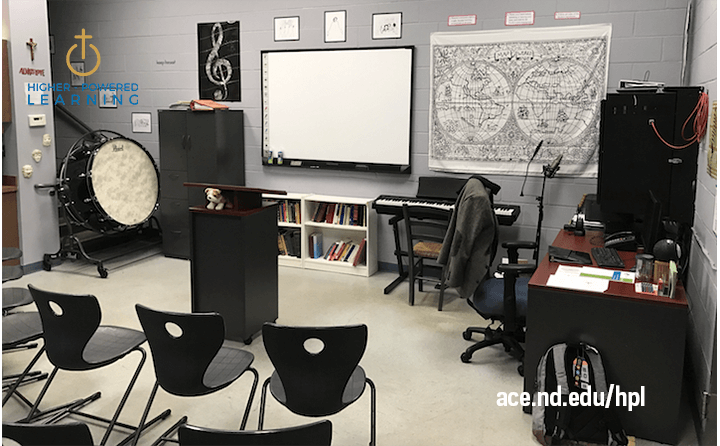When conceptualizing blended learning, we often think of subjects like math, science, and reading comprehension. Performing arts may seem like it's on the opposite side of the learning spectrum from technology - "calculation" vs. "inspiration." Can computers ever enhance performing arts instruction? Brian Scully, the newest member of the HPL Team, writes about his experience teaching music through blended learning and the gift of personalization that technology brought to his classroom.
To the untrained ear, my music classroom often sounded like pure cacophony: 20 laptops all playing different music simultaneously. But to the discerning ear it sounded like well, still cacophony. But sometimes that's just what's needed!
 As much as I integrated technology into my STEM classes, I blended it just as consistently into my performing arts lessons. I'll admit, when most people think of "Performing Arts," they think of powdered wigs and mimes before they consider computers. But for my classroom, blended learning was vital to achieving the level of personalized engagement that art deserves.
As much as I integrated technology into my STEM classes, I blended it just as consistently into my performing arts lessons. I'll admit, when most people think of "Performing Arts," they think of powdered wigs and mimes before they consider computers. But for my classroom, blended learning was vital to achieving the level of personalized engagement that art deserves.
Think back to your Music Appreciation class. Did you appreciate music more after the class? People engage meaningfully with music all the time when Alexa is the only one listening-admit it, you've tried to hit the high B-flat in "Bohemian Rhapsody." But while everyone loves music outside the classroom, many just don't connect with the subject in school. How do instructors promote that "sing-along-with-the-car-radio" passion towards music in their classroom?
The major hurdle is creating an environment where everyone-multi-instrumentalists, shower singers, and casual "music fans"-can engage meaningfully with the material. We found those 20 laptops helped us bridge the gap from being passive listeners to active analysts.
Using technology in the performing arts classroom provides many opportunities for engagement, and not simply because the technology makes music "fun." Music is inherently fun. The technology makes it easier for students to personalize their connection with the lesson's greater framework. Each student can create and learn independently, and, equally as valuable, collaborate with their classmates.
Often after we discussed the major musical idea of the lesson, my students would search Spotify for songs they liked that exemplified the concept. It was no longer an unrelatable memorization task, it was an active consideration of what makes their favorite songs great. Overhearing the diversity of music their classmates found on the subject led to natural, rich conversations comparing the techniques of students' songs.
The direct access to personally significant music led to enthusiastic, unprompted dissections of songs. Nothing beats hearing a student tell another, "Oh, I LOVE that song's hook!" Nothing, that is, except the moment they realize it's catchy because of the same techniques Bach used. (I mean, just listen to that countermelody on the last chorus of "Bye, Bye, Bye.")
YouTube was an overflowing resource that allowed us to explore, for example, the role orchestration has on the character of a piece. Whether playing with pentatonic scales on BeepBox, exploring song structure through The Eternal Jukebox, or visualizing lyrical repetition using SongSim, students were engaged both in the academic study of music and in the serious playfulness of artistic creation. These programs allowed lessons to be individually contextualized for each student. Not only did they encourage practicing the nuts and bolts of theory, they invited students to experience the personal, emotional core of art.
This is the true power of technology in the classroom: personalization. Using blended learning, the performing arts classroom is empowered-the same is possible with all kinds of education. Whether in the music room, the homeroom, or the lab, working with well-implemented technology can help students feel ownership of material and encourage individualized engagement.
Blending your classroom can feel like you are yielding the floor to a distraction machine, but the technology is simply a tool. When students are meaningfully engaged through the technology, that sword is turned into a plowshare. The teacher is no longer the center of the room-the student is.
So when I listened to my classroom, I didn't just hear a jumble of sound. I heard each student engaging with content that was particularly meaningful to them. And not only were they just listening to old favorites, they were reanalyzing something intimately familiar through a new lens. Hopefully they appreciate their favorite songs a little more.
Cacophony, maybe; but within that noise each student speaks with their personal voice.
Looking for more news, updates, and reflections on blended learning?
 Alliance for Catholic Education
Alliance for Catholic Education
